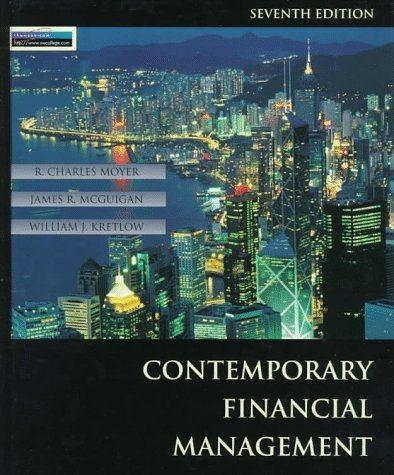Question
Rugged Outdoor Supplies is looking to expand its business. The new business is expected to generate $2.6 million per year in sales over the next
Rugged Outdoor Supplies is looking to expand its business. The new business is expected to generate $2.6 million per year in sales over the next 5 years. Annual costs would increase by $2.1 million. Both sales revenues and costs are expected to increase by 2% per year due to inflation. An investment in working capital of $65,000 would have to be made initially. The machinery (CCA rate of 30%) would cost $635,000, with additional costs of $25,000 to be incurred for setup and training. They also estimate that it would be possible to sell the equipment for 15% of its initial value at the end of 5 years. The company would set up operations in a building it does not use but currently rents out for $80,000 flat per year. If the firm's cost of capital is 8% and its tax rate is 29%, should it proceed with this new business?


Please show calculation. Thank you.
A E F G H K L N O 22 23 24 25 8% Summary 26 29% Tax Rate Initial Investment 27 PV of Cash Flows After Tax 28 Equipment cost |Setup and training Investment in NWC A. Initial Investment $ PV of CCA Tax Shield 29 635,000 25,000 PV of Ending Cash Flows 30 Why: yes 65,000 725,000 NPV 31 Proceed with Project? 32 33 34 Yr 1 2 3 4. 5 Sales 35 Less forgone rental Income 36 Costs 37 Project cash flows before tax 38 ax 39 Project cash flows after tax 40 41 B. PV of Cash Flows After Tax 42 43 A E F G K L N O 39 Project cash flows after tax 40 41 B. PV of Cash Flows After Tax 42 43 C. PV of CCA tax shield formula (if asset class remains open after asset is sold) Salvage value 44 Return of NWc 45 Total ending cashflow 46 CdT 1+0.5 PV= r+d1+r SdT 1 PV of ending cash flows D. 47 r+d} (l+r}" 48 49 Why are interest and sunk costs not included but opportunity costs and externalities are 50 included in the NPV approach to project analysis? C Capital Cost 51 29% d CCA rate for asset class 52 T Corporate tax rate r cost of capital rate 29% 53 29% 54 S Salvage value of asset $ =# years 55 56 5 (0) PV of CCA Tax Shield 57 58 50 A E F G H K L N O 22 23 24 25 8% Summary 26 29% Tax Rate Initial Investment 27 PV of Cash Flows After Tax 28 Equipment cost |Setup and training Investment in NWC A. Initial Investment $ PV of CCA Tax Shield 29 635,000 25,000 PV of Ending Cash Flows 30 Why: yes 65,000 725,000 NPV 31 Proceed with Project? 32 33 34 Yr 1 2 3 4. 5 Sales 35 Less forgone rental Income 36 Costs 37 Project cash flows before tax 38 ax 39 Project cash flows after tax 40 41 B. PV of Cash Flows After Tax 42 43 A E F G K L N O 39 Project cash flows after tax 40 41 B. PV of Cash Flows After Tax 42 43 C. PV of CCA tax shield formula (if asset class remains open after asset is sold) Salvage value 44 Return of NWc 45 Total ending cashflow 46 CdT 1+0.5 PV= r+d1+r SdT 1 PV of ending cash flows D. 47 r+d} (l+r}" 48 49 Why are interest and sunk costs not included but opportunity costs and externalities are 50 included in the NPV approach to project analysis? C Capital Cost 51 29% d CCA rate for asset class 52 T Corporate tax rate r cost of capital rate 29% 53 29% 54 S Salvage value of asset $ =# years 55 56 5 (0) PV of CCA Tax Shield 57 58 50Step by Step Solution
There are 3 Steps involved in it
Step: 1

Get Instant Access to Expert-Tailored Solutions
See step-by-step solutions with expert insights and AI powered tools for academic success
Step: 2

Step: 3

Ace Your Homework with AI
Get the answers you need in no time with our AI-driven, step-by-step assistance
Get Started


